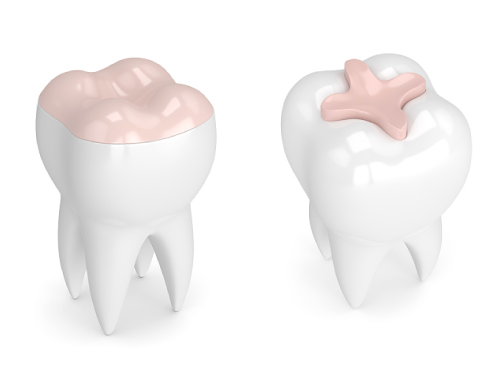Whenever you mention the term “tooth damage,” you may immediately create an image of fillings or crowns. However, what will we do when the amount of the damage is not large enough to warrant a crown but is too much for a simple filling? This is where dental inlays and dental onlays are introduced; they are some of the modern forms of restorations that your dentist might suggest in order to save your tooth before the disease can worsen.
A significant number of individuals are surprised by the fact that these treatments can strengthen a tooth, enhance its appearance, and protect it over several years. This guide will take you through the entire process, as much as you have been informed that you require one or are just interested in how they operate.
Understanding Dental Inlays and Dental Onlays
What Are Dental Inlays?
A dental inlay is a cast restoration that is used to restore the inner part of a damaged tooth.
It slides easily into the crevices of your tooth without sealing the ridges (curved ends). The inlays are normally advised where the cavity or crack is too large to be filled but too small to be considered large enough to have a complete crown.
What Are Dental Onlays?
A dental onlay serves the same purpose, but it covers a bigger area.
Onlays cover one or more tooth cusps, unlike inlays, which cover only one cusp. The dentists use onlays to refer to partial crowns, as they offer a lot of support with minimal destruction of natural tooth structure compared to full crowns.
Why Dentists Prefer Inlays and Onlays for Certain Types of Damage?
1. They Preserve More Healthy Tooth Structure
The most significant benefits of inlays and onlays are that they do not require a lot of removal of your natural tooth.
Fillings can be considered a weakness in a tooth when they are huge, and crowns may need to be significantly reshaped. Onlays and inlays would be the best balance of the two because they:
- Strengthening the tooth
- The remnant of the building was safeguarded.
- Maintaining the procedure with minimalism.
The general trend of modern dentists is to save as much of the natural tooth as is possible, and these alternatives are very conducive to that.
2. They Offer Stronger, Longer-Lasting Protection
Whereas fillings are likely to wear or dislodge over time, inlays and onlays are made of hard materials such as porcelain or composite resin. The following properties of these materials characterize them:
- Excellent strength
- Resistance to staining
- Natural appearance
It implies that the reconstructed tooth can cope with the daily chewing of many years and decades with proper maintenance.
3. They Provide a Precise, Custom Fit
Every inlay/onlay is made in a dental laboratory based on digital scans/molds of your tooth. This ensures:
- A perfect fit
- A natural feel in your mouth
- Reduced risk of future decay
The restoration is bonded with high precision, allowing it to be easily blended with the shape and color of your tooth.
4. They Reduce the Risk of Future Damage
A tiny crack or cavity may develop rapidly when a tooth is weakened. Onlays and inlays support the tooth structure by bringing in strength. This reduces the chances of:
- Cracks spreading
- Tooth fractures
- Dental attention during an emergency.
An inlay or onlay may also prevent you from having to have a full crown in many instances by making the correct decision at a young age.
The Procedure: What to Expect
Though every dental clinic has its own working process, the overall sequence is usually:
Step 1: Examination & Scans
The dentist analyzes the tooth he has damaged and scans it digitally to model the inlay or onlay.
Step 2: Tooth Preparation
Carefully, the decay or old filling material is removed. Nothing more; it is only shaped in the damaged area.
Step 3: Temporary Restoration
In the meantime, you can be provided with a temporary cover as the tailor-made one is being made.
Step 4: Final Placement
The onlay, or the inlay, is attached to the tooth by a strong adhesive. The restoration is polished by the dentist to appear and feel natural.
Final Thoughts
Dental onlays and dental inlays are a perfect option for restoring damaged teeth with no impairment to their strength and appearance. They are hard-wearing, accurate, and long-lasting, making them one of the best restorative materials on the market today.
Now is the right time to act if you are experiencing pain in your teeth, if your old fillings are worn out, or if there is an indication of damage. Nick Dental provides modern and friendly restorative care that is patient-friendly and helps you maintain your natural smile for a long time.


